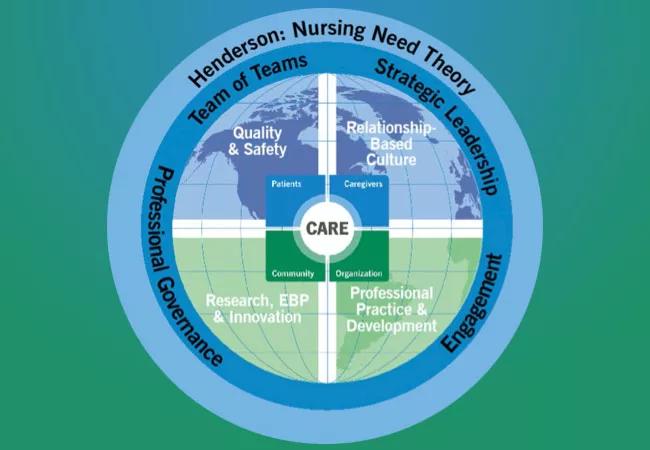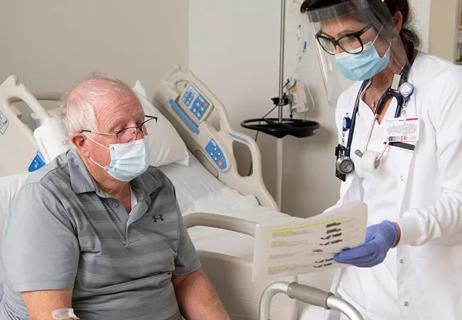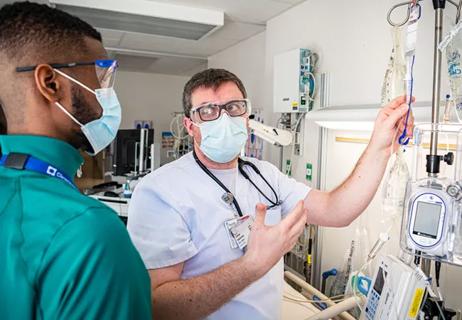Domains, values and elements of nursing practice

From Chief Caregiver Officer K. Kelly Hancock, DNP, RN, NE-BC, FAAN
Cleveland Clinic is a non-profit academic medical center. Advertising on our site helps support our mission. We do not endorse non-Cleveland Clinic products or services. Policy
When the Cleveland Clinic Stanley Shalom Zielony Institute for Nursing Excellence was formed in 2009, one of the institute’s top priorities was to develop and implement a unified nursing practice model for all Cleveland Clinic nurses.
Thus, the institute launched Cleveland Clinic’s first-ever nursing Professional Practice Model (PPM) – a framework designed to support and guide nurses to manage their everyday practice and ensure delivery of high-quality care to patients.
Through the years, the model has helped the Nursing Institute address challenges, identify opportunities and advancements in healthcare, and more. Recently, Cleveland Clinic’s executive nurse leaders refreshed the model to better reflect Cleveland Clinic’s current nursing practices, policies, values and care priorities. Similar to the original model, the revised model aligns nursing practice with Cleveland Clinic’s mission, vision and values and continues to guide the institute to nursing excellence.
The original PPM was centered on Cleveland Clinic’s ‘Patients First’ guiding principle and was designed to help nurses deliver consistent care to an infinite variety of patient and family needs. The model included a foundation of system thinking based on ‘Shared Vision’ (based on work by P.M. Senge). This allowed the following concepts of care to be combined into a Framework of Care: ‘Serving Leader’ (based on work by R.K. Greenleaf), ‘Relationship-based Care’ (based on work by M. Manthey) and ‘Thinking in Action’ (based on work by P. Benner).
The Framework of Care formed the foundation for nursing practice and encompassed four domains of influence, also known as quadrants. These allowed customization for a nurse’s specific role, professional goals, and personal preferences, and were:
Keeping the same consistent visual feel of the original model, the revised model continues to depict the Nursing Institute’s values and defines the structures and processes that support nurses to own their practice and deliver quality care. At its center, the revised model focuses on Cleveland Clinic’s four care priorities:
Nurses support these care priorities through Cleveland Clinic’s values of quality and safety, empathy, teamwork, integrity, inclusion and innovation. In alignment with the care priorities, professional goals and responsibilities ensure that nurses provide each patient a lifetime of high quality, seamless care enabled by technology; create an inclusive and supportive culture that empowers caregivers to thrive; steward their resources, enabling Cleveland Clinic to grow responsibly and serve as many patients as possible; and, serve communities by tailoring care to meet unique needs and ensure better health.
The theoretical foundation of the revised model is the ‘Nursing Need Theory’ (based on work by V. Henderson). It is centered around the following definition of nursing: “The unique function of the nurse is to assist the individual, sick or well, in the performance of those activities contributing to health or its recovery (or to peaceful death) that he would perform unaided if he had the necessary strength, will or knowledge.”
The theory reinforces Cleveland Clinic nurses’ commitment to nursing excellence by providing the best possible care and helping the patient to become as healthy and independent as possible.
Additionally, to help the Nursing Institute achieve its mission to be the global leader in the professional practice of nursing, the revised model incorporates the following overarching themes:
Team of teams: High-performing cross-functional teams work together, creating a team of teams. Everyone is aligned for a common purpose – to take the best care of patients.
Strategic leadership: Provides direction to the organization by outlining a vision for future growth, maintaining stability and managing through change. All nurses are leaders. By exerting character traits that empower others to collectively and collaboratively achieve a goal, nurse caregivers can influence those around them to create momentum.
Engagement: Nurse caregivers are actively involved in the organization to ensure sustainability and growth. Patients and their families, along with the healthcare team, are active participants in planning and implementing care.
Professional governance: Nursing practices a shared decision-making model where nursing and other caregivers in the interdisciplinary team have the power to make decisions and are accountable for their actions.
As can be inferred from the ‘professional governance’ theme, the revised PPM, like the original, is a driver of shared governance at Cleveland Clinic. The PPM continues to be at the center of the Nursing Institute’s Shared Governance Model, which empowers nurses by giving them a voice in the decision-making processes that affect their practice and the care they provide patients.
The last revision to the PPM was made to the model’s four domains of influence, which further define how the model is implemented in daily practice. The new domains/quadrants are:
Quality and safety: Nurses provide safe care where patients and caregivers achieve high-quality outcomes.
Relationship-based culture: Captures the relationships of nurses with patients, each other, other caregivers and the community.
Professional practice and development: Nurses embrace life-long learning and continuous professional growth to advance the professional practice of nursing.
Research, evidence-based practice and innovation: Evidence guides clinical practice and management. Through research and innovation, nurses transform healthcare to provide the best outcomes for patients.
The revision of the Nursing Institute PPM was led by a steering committee consisting of nursing representatives from throughout Cleveland Clinic health system and representing each hospital. Committee members reviewed the original model, collected feedback from all nursing practice councils throughout the health system and more to identify recommendations for the revised model. The revised model continues to be a symbol of unity, uniting the Nursing Institute on its path to deliver all Cleveland Clinic patients world-class care.

Phone triage system reduces call backs and delays in care

New protocol reduces costs, increases patient and caregiver satisfaction

New options benefit caregivers, nursing units and patients

Nurses facilitate preoperative program to educate and prepare patients for ongoing care

Introduces at-home work and new patient screening tool

Health disparities, mental health and more

Ideas for approaches to prevention, response and more

Educating and developing generations of nurses